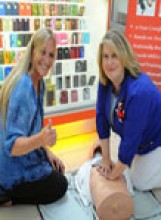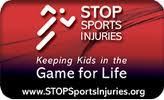Archive for Uncategorized
Halloween Safety Tips
Posted by: | CommentsWhy was the skeleton afraid to cross the road? It had no guts…
Ghost, goblins and vampires…Halloween will soon be here. For kids, Halloween is an exciting holiday and nothing ends a great time more quickly than a trip to the emergency room. To ensure a happy venture, here are some “tricks” for a safe Halloween.
Motorists
- Watch for children darting out between cars.
- Watch for children walking medians and curbs.
- At twilight and later into the evening, watch for children in dark costumes.
Parents
- Designate an adult or older child to supervise younger children during the outing.
- Plan and discuss the route the trick-or-treaters, plan to follow.
- Instruct children to travel only in familiar areas.
- Teach children to stop only at houses that are well-lit and to never enter a stranger’s home.
- Remind children of safety rules about crossing the street.
- Always have them walk and not run.
- Tell them to only eat candy that you have inspected first.
Costume Design
- Use only fire-retardant materials for costumes.
- Costumes should be loose, so that warmer clothes could be worn underneath.
- Costumes should not be so long that they become a tripping hazard (falls from running, tripping over lawn decorations or costumes are the leading cause of Halloween injuries).
- Costumes should be of light colored or use strips of reflective tape to make children visible at night.
Masks or makeup
- Masks can obstruct a child’s vision. Facial makeup is a better alternative.
- Make sure the Halloween makeup is labeled with “Made with U.S. Approved color Additives, “Laboratory Tested”, Meets Federal Standards for Cosmetics, or “Non-Toxic”. Follow manufacturer’s instruction for application.
Accessories
- Knives and swords should be made of flexible materials. Do not allow children to carry sharp objects.
- Carrying flashlights will help children see better and be seen more clearly.
Remind children before going out the following rules:
- Do not enter any homes or apartments without you being with them.
- Walk, don’t run between houses. (Tripping over unforeseen objects and uneven terrain can end their evening early)
- Walk on the sidewalks and not in the street.
- Always look both ways before crossing streets.
- Cross all streets at the corners.
Miscellaneous:
- Give children a meal before the outing.
- Use the restroom just before leaving the house.
- Inspect all candy before allowing children to eat them.
- When in doubt, throw it out.
Following these simple safety rules and everyone will have a “fang…tastic” time.
Can Men Get Breast Cancer?
Posted by: | CommentsEven though it’s not as common as in women, men can develop breast cancer. Men have the same breast tissue as do women only that the tissue does not expand or develop further during puberty. Though there is a smaller amount of breast tissue, this tissue is still susceptible to cancer.
It is very rare for a man under the age or 35 developing breast cancer, but the chances do increase with age. The symptoms for breast cancer in a man are similar to a woman. Look for a lump on the chest, bleeding of the nipples or abnormalities in the skin above the cancer.
Treatment for breast cancer in men are the same used for women and in some cases men respond better. The major issue for men is awareness that they can develop breast cancer and waiting too long before receiving treatment. This allows the cancer to spread to the lymph nodes and makes treatment and the possibility of surviving, much harder.
If you find any abnormalities or lumps on your chest, make an appointment with your physician.
RICE That Injury
Posted by: | CommentsInjuries to soft tissue such as sprains and strains, though not life threatening are still pretty painful. It is universally accepted to RICE those injured sites. We are not suggesting that you use “Uncle Ben’s” or “Risotto” on these injuries, instead using RICE as an acronym for steps to take in the treatment of soft tissue injuries. It’s best to perform these treatments within the first 48 hours of the injury. If fact, the sooner you can begin treatment the better.
For soft tissue injuries complete the following steps:
R Rest the injured site, get off of it or greatly reduce the use of that injured body part.
I Ice to control swelling. The best formula for icing is to ice the area for 20 minutes and then remove the ice for at least the same period of time before reapplying. Continual icing of a limb or injured area can actually cause more swelling. Interval icing, as suggested, is the best process.
C Compression. Wrap the injured area with a Ace Bandage to also help control swelling, as well as adding support to the injury.
E Elevation. Elevate the injured body part above the heart as much as you can during the day and evening
.
Following these easy first aid steps can help reduce the pain the victim is experiencing, as well as reduce the overall recovery time.
Is This the New AIDS for the US?
Posted by: | CommentsIt’s estimated 300,000 people in the US have Chagas and over 8 million worldwide. Chagas is a tropical disease that is working its way up into the Northern Hemisphere. Currently over 20,000 people die each year from this disease.
The initial symptoms are similar to AIDS, chronic conditions that require prolonged and expensive treatments and can be transmitted from mother to infant or blood transfusions, but unlike HIV the most typical transmission process is through insects, particularly the Kissing Bug.
This insect is particularly attracted to the odors which humans release when they breathe and is the reason why most bites are in or around the mouth (hence the nickname). This bug enjoys being amorous during the evening and usually strikes during the night when you are sleeping.
Chagas disease comes from a parasite that lives inside the digestive tract of this insect. Never known as a conscientious lover, after having its way with you the Kissing Bug will urinate or defecate in or around the bite site. This allows the parasite access to enter into your body and can have life threatening consequences.
Victims of Chagas can develop enlarged hearts and intestines, which over time can rupture, fail or even burst, causing instant death. Some people can have a severe allergic reaction to the insects saliva. Even when diagnosed doctors are finding it hard to almost impossible to cure their patients. Since the medicine to treat those infected with Chagas is extremely toxic to human in the first place.
Heat Illness
Posted by: | CommentsHeat exhaustion is the most common heat illness. Signs and symptoms of heat exhaustion are:
- Heavy sweating.
- Feeling dizzy or faint.
- Rapid or weak pulse.
- Nausea.
- Possible cramping.
- Headache.
- Fatigue.
- A dark color to their urine.
Your first priority in dealing with an individual suffering from a heat illness is to remove the victim from the hot environment. If they are in the sun, move them into the shade. If they are in a hot room, move them into a cooler room. Lay the person down, loosen or remove any restrictive clothing.
Since the person is probably dehydrated, begin giving the victim cool water or a sports fluids. Try not to give them anything that is extremely cold. As their condition improves allow them more and more water. DO NOT give them anything that is caffeinated. You do not want to elevate the victim’s heart rate. Realize most sodas contain caffeine. Spray or sponge the victim with cool water and continue to monitor the victims condition.
If the victim faints, becomes confused or has a seizure, call 911 immediately. If the victims body temperature rises above 104 F, the person is in Heat Stroke, a life threatening condition. Continue to try and cool the victim while you wait for the Emergency Service Personnel to arrive. Areas on the body that are sensitive in helping cool a victim is, the top of their head, in the armpits and below in the groin area. Use cool wraps or packs in these areas. Reference: Safety – 250
Safest Seats on an Airplane
Posted by: | CommentsCan where you sit make a difference in surviving an air-crash? Most airlines and aeronautic experts say there isn’t a difference but, Popular Mechanics did a study of air crashes from 1971 and found some interesting information.
It is recognized that there are two times during an air flight when more accidents occur. In fact, over 75% of all accidents occur either during the take-off or the landing of the aircraft. But don’t let this fact deter you from flying. The statistics show that flying, by commercial aircraft, is 22 times safer than driving a motor vehicle on US roadways.
Also the type of crash had an influence. Certain crashes changed the desired safest seat location, but on average the seats located towards the rear of the plane had the best survival rates. You may be giving away some comfort by choosing a seat towards the rear since the most stable seats especially for those of you that contend with motion sickness, would be the ones directly over the wings.
First class passengers may be more comfortable than the rest of the passengers, but the front of the plane has the lowest survival rates in air-crashes.
Here is the breakdown on survival rates:
First Class 49%
Ahead of Wing 56%
Over Wing 56%
Rear Cabin 69%
So if you are susceptible to motion sickness you may want to consider a seat with the least movement (over the wing), but if you are looking for just safety, then selecting a seat towards the rear of the plane as your best bet.
Can Driving Impair Your Hearing?
Posted by: | CommentsNew research shows that driving a convertible with the top down can damage your hearing. Many of us find nothing better than driving a sports car with the top down on beautiful spring or summer day. The wind blowing through our hair and the warmth of the sun on our face makes the drive a very enjoyable experience. But a new study indicates that this mode of travel may have consequences on our hearing.
Researchers tested several makes of automobiles with convertible options. In these test they found that the noise of the wind, while traveling at speeds of 55 mph (or greater), created levels of noise at 85 decibels or higher. This is equivalent to the sounds of a garbage disposal or vacuum cleaner and in the range to cause hearing loss if over an extended period.
Also there were dramatic noise spikes from passing motorcycles, trucks or buses. In all tests the car’s radio were turned-off, car horns were not used and the weather was in good conditions. No excessive decibels levels were recorder when the top was up and secured.
Researchers recommend that if you have a convertible automobile, you should consider driving with the top up for any long extended rides.
Prostitutes Using AEDs
Posted by: | CommentsProstitutes are being trained to use defibrillators!
Several brothel owners in a small lakeside Swiss town have begun training their staff (prostitutes) in the use of an Automated External Defibrillators (AED). One sex club owner stated: “Having customers die on us isn’t exactly good publicity”.
During strenuous activities, such as sexual intercourse, an additional burden is placed upon your cardiac system and may cause many men in poor health to go into cardiac arrest. When an incident occurred, emergency medical services was called and the staff began CPR chest compressions on the client. Another staff member would immediately retrieve the AED. AEDs have shown to be very instrumental in helping correct a heart that’s in fibrillation.
Studies have shown that resuscitation rates from cardiac arrest increases significantly when an AED is used in conjunction with CPR within the first three minutes of a victim going into ventricular fibrillation. The longer it takes for this to happen the chances of survival decreases sharply. In most cases waiting for the ambulance to arrive, may be too late.
With AEDs available and prostitutes trained in there use, these brothels are creating an extra layer of safety and protection for their clientele.
Analphylaxis
Posted by: | CommentsAnaphylaxis is a severe allergic reaction to a certain substance. Adults and children can have allergic reactions to several different substances. Which may include: poison plants, animal scratches or dander, pollen, latex, bee stings, medications, nuts, shellfish and molds.
Anaphylaxis can affect about 15% of the population. The allergic reaction will continue as long as the victim remains in contact with the allergen. It is best to remove the substance or allergen as quickly as possible. Remove stingers or wash effected areas with soap and water where the toxins have touched. The general signs to look for in an allergic reaction are:
- Itching
- Redness
- Hives
- Scratchy Throat
- Difficulty Breathing
- Dry Mouth
- Dizziness
- Weakness
Those who have experienced a severe reaction to a substance should consult a doctor and carry an Epi-Pen. This is a prescribed and easily injectable dose of epinephrine, which helps counteract the severe allergic reaction. Without epinephrine an anaphylactic reaction could quickly become fatal.
Reference: First Aid– 165
Water Safety
Posted by: | CommentsAs summer approaches and the days get warmer, more people are finding fun and relaxation through water activities. This increases the risks of water related injuries and deaths. In 2005, there were over 4,000 reported drowning’s in the United States, averaging more than 10 deaths each day.
Drowning is the second leading cause of death among children ages 1-14. Children under the age of 1, most often drown in bathtubs, buckets or toilets, whereas children ages 1- 4 years, have more occurrences in backyard swimming pools. In most cases, children are out of an adults sight for less than 5 minutes. Even non-fatal drowning can cause severe brain damage due to the lack of oxygen.
To help prevent water related injuries:
1) Designate a responsible adult to watch young children while in the bathtub, swimming or playing in and around water. Be aware of distracting activities such as, answering the phone, reading or doing household chores. As stated earlier, it only takes a few minutes for a child to slip under the water and drown.
2) Have your children learn how to swim, but do not use this as an excuse to leave them unattended at any time.
3) Children should wear PFDs (Personal Flotation Devices) whenever they are in or around open water or participating in water sports.
4) Install a four-sided, isolation pool fence, which is completely separated from the house or children’s play area.
5) Remove all floats, balls or toys from the pool after all swimming activities. Many young children fall into pools trying to obtain these items.
6) Learn CPR (cardiopulmonary resuscitation). In the time it takes Paramedics to arrive, most victims have suffered sufficient amount of brain damage, that they cannot be resuscitated. Using CPR skills on a drowning victim has shown to significantly improve a victims chance of survival.
By initialing these safety guidelines you can create a safer environment your children.







